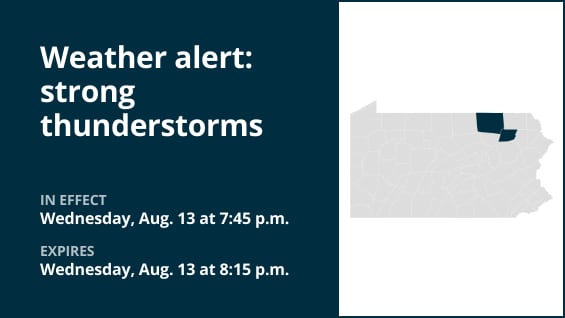At 7:45 p.m. on Wednesday, the National Weather Service issued an updated forecast for Bradford and Wyoming counties, predicting severe thunderstorms until 8:15 p.m.
Be prepared for wind gusts of up to 40 mph and pea-sized hail (0.25 inches).
“At 7:44 p.m., Doppler radar tracked a strong thunderstorm near Sugar Run, or near Wyalusing, moving southeast at 20 mph,” according to the meteorological service. Gusty winds have the potential to blow around unsecured objects and topple tree branches. There is a chance of minor hail damage to vegetation.
Hollenback, Noxen, Mehoopany, Meshoppen, Forkston, Laceyville, Kasson Brook, Evans Falls, Lake Carey, and Lovelton are among the places affected by the warning.
According to the weather service, “If you’re outside, think about taking cover inside a building.” This storm is causing frequent lightning strikes from the clouds to the ground. Ten miles can separate a thunderstorm from a lightning strike. Look for a secure place to hide inside a building or car.
When lightning looms: Expert safety tips for thunderstorms
About 25 million lightning strikes occur in the US annually, primarily in the summer. The weather service estimates that it kills around 20 people a year. As thunderstorms get closer, the risk of lightning increases; it peaks when the storm is directly overhead and then progressively decreases as it passes.
Consider the following advice to keep yourself safe during a thunderstorm:
Plan for lightning safety:
-
When venturing outdoors, it’s vital to establish a clear plan for seeking shelter in case of lightning.
-
Monitor the sky for threatening signs and listen for the sound of thunder. If thunder is audible, it’s an indication that lightning is nearby.
-
Seek a safe place to shelter, preferably indoors.
Indoor safety precautions:
-
Once you’ve found shelter indoors, abstain from using corded phones, electrical appliances, or plumbing fixtures, and refrain from approaching windows and doors.
-
Lightning can follow conductive pathways, and these precautions reduce the risk of electrical surges.
Hold off till the all-clear:
-
After the last lightning strike or thunderclap, wait at least 30 minutes before resuming outdoor activities.
-
Lightning can strike even when a storm has seemingly passed, so exercise caution.
When there is no indoor shelter:
Take these precautions to increase your safety if you are outside during a thunderstorm without access to indoor shelter:
-
Avoid open fields, hilltops, or ridge crests, as they expose you to greater lightning risk.
-
Steer clear of tall, isolated trees and other prominent objects. In wooded areas, stay close to lower stands of trees.
-
If you’re in a group, ensure that individuals are spaced out to prevent lightning current from transferring between people.
-
Camping in an open setting during a thunderstorm is strongly discouraged. If you have no alternative, set up camp in a valley, ravine, or other low-lying areas. It’s crucial to note that a tent provides no protection against lightning.
-
Do not approach water bodies, wet objects, or metal items. Although water and metal do not attract lightning, they conduct electricity effectively and can pose significant risks.
In conclusion, readiness and alertness are your greatest allies while dealing with the threat of lightning. You may put your safety first and drastically lower the chance of lightning-related mishaps by adhering to these rules.
Driving through downpours: Safety guidelines for wet roads
Roads can become dangerous when it rains. Keep yourself updated and heed these weather service recommendations to stay safe during periods of intense precipitation:
Watch out for flooding rivers:
When it rains a lot, stay clear from parking or strolling near culverts or drainage ditches since the swift-moving water could carry you away.
Keep your distances from other vehicles safe:
Keep a safe distance from the automobile ahead of you by following the two-second rule, and give yourself an extra two seconds if it’s raining a lot.
Reduce your speed and drive carefully:
Lowering your speed is essential on wet roads. To prevent skidding, reduce the accelerator gradually rather than braking suddenly.
Pick your lane carefully:
Water tends to pool in the outside lanes, so stick to the central ones.
Put visibility first.
Turn on your headlights to improve visibility in severe rain. Rain-stained windows can hide cars in blind situations, so be cautious.
Be cautious on slick roads:
Because of a combination of rain, oil, and grime, roadways are at their slickest during the first 30 minutes of precipitation. Be especially careful during this time.
Stay a safe distance away from big cars:
Avoid following buses or big vehicles too closely. Their big tires produce a mist that blurs your eyesight. Additionally, if you have to pass them, proceed with caution.
Be mindful of your wipers:
Visibility may be hampered by overloaded wiper blades. If the rain significantly impairs your vision, stop and wait for the weather to clear up. Seek cover in safe spaces or rest areas.
If you can’t avoid the roadside, pull off as far as you can, ideally past the end of a guard rail, and wait for the storm to pass. To let other cars know where you are, turn on your emergency flashers and keep your headlights on.
You may greatly lower dangers and protect your health when it rains a lot by adhering to these safety precautions. To ensure a safe and sound voyage, keep yourself updated on weather conditions and follow local authorities’ instructions.
United Robots offers a service called Advance Local Weather Alerts that gathers the most recent information from the National Weather Service using machine learning.






